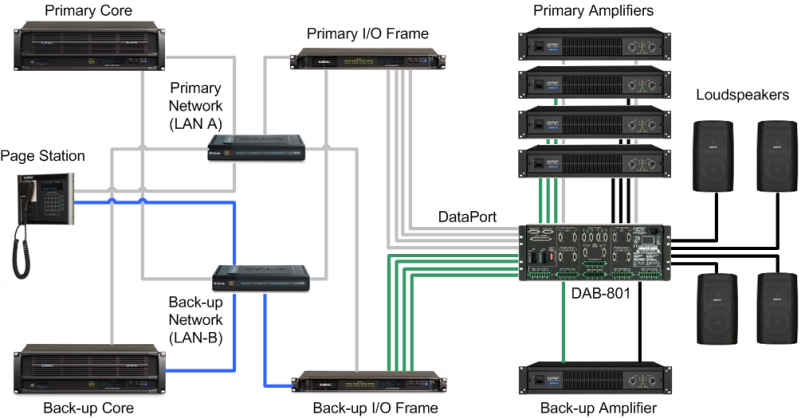Q-SYS Redundancy
Q-SYS is capable of several redundant configurations to ensure a high level of overall system reliability.
- 2N Core redundancy - Two Cores, primary and redundant, communicating with each other and peripherals to verify system health, and to synchronize control settings.
- 2N I/O redundancy - For each peripheral, such as an I/O Frame, you can have a backup peripheral.
- N1 Amplifier redundancy - One amplifier can back up from one to eight amplifiers with the Q-SYS DataPort Amplifier Backup Panel.
- 2N Network redundancy - Two separate networks - In this configuration, you can have each Q-SYS Core and/or I/O Frame connected to both networks.

Network Redundancy
Both the Core and the I/O Frame have two network ports, LAN A (primary), and LAN B (backup). The LAN B port on I/O Frame becomes active when it is configured in Q-SYS Designer as "Is Network Redundant" and connected. Because the I/O Frame is configured in the design file, the Core recognizes it as being on LAN B as well as LAN A. During operation, the Core routes audio and control signals to both ports, so if LAN A, or a part of LAN A fails, the Core switches to LAN B with no failover time.
To learn more, see Network Redundancy.
Q-SYS Hardware Redundancy
The Core and I/O Frame can have backups connected to the network. Both are identified in Q-SYS Designer as being redundant. The backup Core communicates with the primary to ensure it is up to date with any changes made on the primary, and to monitor the primary Core's health. The Core monitors the I/O Frames, if there is a problem detected with the primary I/O Frame, the Core switches to the backup. The audio inputs and outputs of the primary and backup I/O Frames are wired in parallel, meaning that the audio source drives two inputs. The audio outputs of an offline I/O Frame are disconnected by relays, so only the active I/O Frame, in a redundant pair, drives the outputs.
The DataPort Amplifier Backup Panel (DAB-801) provides N+1 redundancy for the DataPort amplifiers and can be used in Life-Safety applications. The DAB-801 can support redundant network and I/O Frames, and four 2-channel or two 4-channel amplifiers per panel. Two panels can be stacked, doubling the amplifier count.
To learn more about Q-SYS hardware redundancy, see:
